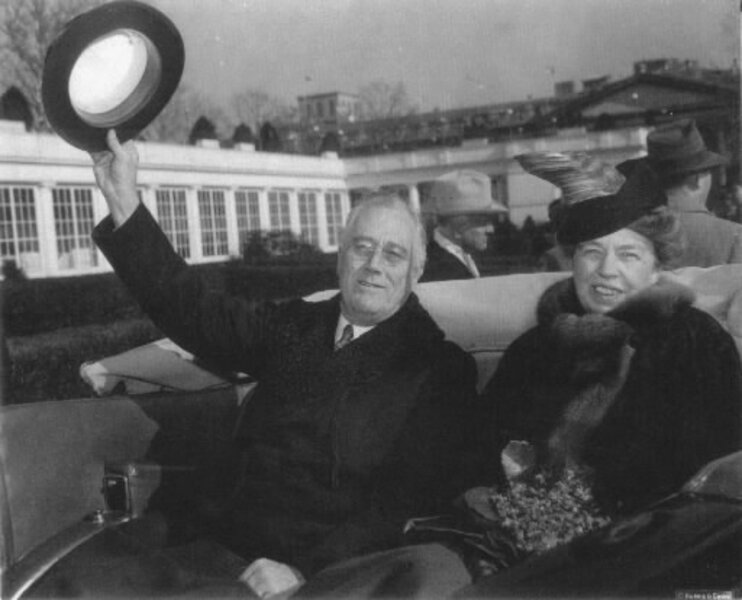America's best first lady: Eleanor Roosevelt tops the list, again
Loading...
Who is the best first lady of them all?
Well, it’s Eleanor Roosevelt, of course, according to a Siena/C-SPAN poll of 242 historians and political scientists that rated her well above her so-called competitors.
That’s the same answer that the poll’s respondents have given each of the five times that the poll has been taken over the last 32 years.
Indeed, on the whole, three decades of respondents – in 2014, 2008, 2003, 1993, and 1982 – have been consistent in their picks for first lady superlatives. In the latest results, Abigail Adams came in second for the fourth time, and Jacqueline Kennedy and Dolly Madison, also long-time high-placers, came in third and fourth.
Michelle Obama, new to the list, came in fifth, and Hillary Clinton, a consistent top-biller since 1993, was in sixth place. Lady Bird Johnson, Betty Ford, and Martha Washington, and Rosalynn Carter rounded out the Top 10.
“What’s surprising is the incredible consistency this poll has shown for 32 years,” says Don Levy, director of the Siena Research Institute in Loudonville, N.Y. “Still, Eleanor Roosevelt is far and away the top-rated first lady.”
“It’s not even close,” he says.
But if Mrs. Roosevelt is the “best” first lady, she is not the best candidate for president, the respondents said, in a separate question that asked which of the women they could “most imagine” in the head of state role. That superlative, a timely one, goes to Mrs. Clinton, who is currently weighing a bid for the 2016 primaries.
On that question, Roosevelt is second – but with half as much as support as Clinton – and Mrs. Obama placed third.
Coming in at the bottom five of the “best” list were: Margaret Taylor, Florence Harding, Letitia Tyler, Eliza Johnson, and Jane Pierce. Laura Bush, Pat Nixon, Mamie Eisenhower, and Bess Truman were all voted in a separate question in the poll as having “could have done more” while in the unofficial office.
The first ladies were judged on 10 qualities, including courage, public image, value to the president, and “being her own woman.” Roosevelt, regarded as a strong, politically active person who led an independent life from her husband, ranked top in six of those categories.
“She set the tone that subsequent first ladies measure themselves against,” says Dr. Levy. “It will take an incredible person to supplant her.”
As in past years, the top of the “best” list is flush with women that no or few living people ever knew – a point that, at times, might benefit these first ladies in the polling, depending on how the historical record tends to view them at the moment.
“In some cases, they have the benefit of being credited with things that might not be historically accurate,” says Levy.
Mrs. Madison, a long-time poll favorite, is remembered in pop culture for her rushing The White House’s most irreplaceable baubles and artifacts out of the building before the British torched the president’s residence during the War of 1812. But, historical evidence has begun to suggest that “this might not have happened,” says Levy.
Mary Todd Lincoln, usually among the bottom five in the poll, also went up in the rankings after the 2012 movie “Lincoln” offered a “sympathetic” image of her, revising a long-held account of Mrs. Lincoln as a difficult, mentally-ill “burden” to the president, he says.
The next poll will be held within the next six to eight years, at which point it will be interesting to see how ever-increasing expectations for first ladies affect the rankings, says Levy.
Since at least Mrs. Kennedy’s much-televised time in the first lady role – during which she and her designer suits and gowns became the sartorial barometer by which subsequent first ladies are still judged – first ladies have had a tough list of standards to meet, says Levy: choose, champion, and change a particular cause; be a doting parent, a supportive spouse, and a fabulous social entertainer; and be a snappy, even iconic, dresser.
(The poll also found that three-quarters of respondents do not think the first lady should be paid).
Mrs. Obama, a bona fide celebrity, has lobbied for her cause – nutrition – while holding court as a national fashion icon on major magazine covers and as a symbol of exceptional parenting as she raises her two daughters.
“The demands of the office continue to be ratcheted up,” says Levy. “It’s an awful tall order at this point.”








